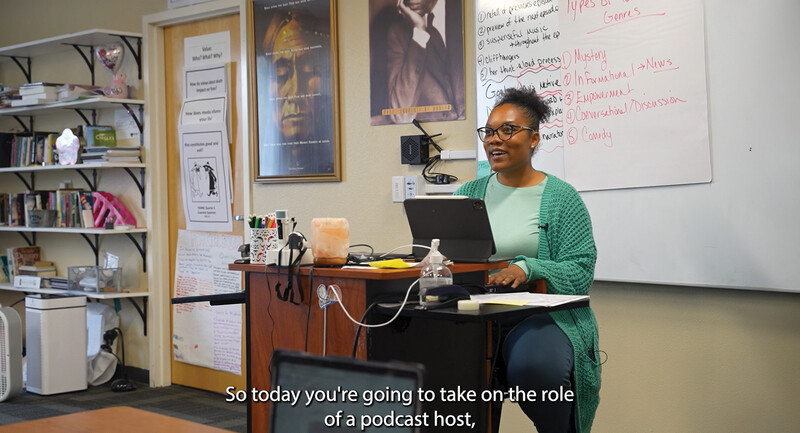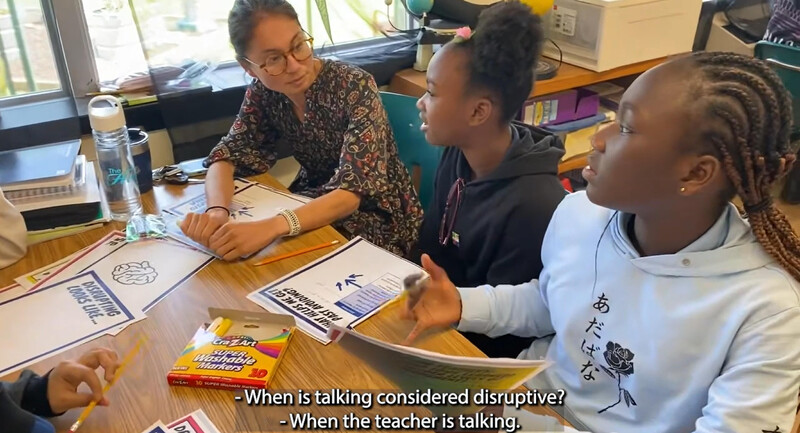This series of deep learning commentaries is built on the idea that strong basic and deep learning content, skills, and attitudes are important for all students to develop in a complex, technological, information, service centered 21st-century economy and culture.
So far in this series, we have focused on why deep learning is important; on defining and describing the goals and characteristics of both basic and deep learning; and on exploring the relationships between three levels of engagement and learning, useful for observation and analysis.
In this commentary, I focus on some related and very practical and important questions: How might a teacher develop their instructional plans so as to incorporate strong basic and deep learning? How can teachers improve student engagement, basic and deep learning? I suggest a planning and instructional framework that will help teachers raise the level of student engagement and promote more powerful learning.
- Setting the Stage: Setting and clarifying goals, initially engaging students, diagnosing background knowledge, understanding and skills, developing interest, building curiosity.
- Promoting Basic-Foundational Learning: Equipping students with foundational knowledge, understanding and core skills
- Developing Deep Learning: Refining, enlarging and extending understanding, processes and skills, and applying learning to new and novel situations
- Closure: Opportunities for students to complete a product or products, demonstrate and explain what they have learned, and share their work with others.
Below is a more detailed description of each of the stages in this framework, along with sample activities that illustrate instruction in each of the four stages:
1. Setting the Stage
During this stage of instruction, teachers build interest in learning by sharing, clarifying and setting goals, engaging students in activities that develop interest and curiosity, diagnosing student background knowledge, understandings and skills; and sharing assessments, expected performances and end products.
Some examples of “setting the stage” activities include:
- Activators are designed to develop a student’s interest in the goals of a unit and to diagnose and activate prior knowledge and skills related to the goals of a unit. They include many introductory teaching strategies, such as 3-2-1 (e.g. list 3 things you already know about X, 2 things you’d like to know about or learn more about, and 1 question related to the key concept or learning), beginning Journals, Anticipation Guides, and others. You can find descriptions about multiple activator strategies here.
- Essential Questions activities are designed to introduce essential questions and use them to determine background knowledge and understanding and initiate writing and discussion activities that elevate interest and inquiry into a unit of study.
- Performance and Project overviews are designed to introduce unit performances, tasks and projects, such as culminating performance assessments and projects that students will complete, writing tasks, logs and reflections, discussions, debates, and simulations
2. Promoting Basic-Foundational Learning
During this stage, students learn core knowledge, develop basic understanding, and begin or continue to learn and refine multiple basic, key skills. They build knowledge connections and relationships through sequencing, concept formation, narratives, and other basic knowledge and skill-building strategies. They demonstrate their knowledge and understanding through explanation and interpretation.
Some sample activities include:
- Notetaking and other study skill activities provide students with ways to collect, valuate, organize and synthesize reading and other sources of information.
- Building Vocabulary and Making Connections are activities that help students learn, define, connect, and use new words and phrases related to what is being learned.
- Sequencing and Patterning help studentscreate chains of events, narratives, and patterns that provide the basis for developing and understanding basic causal links, mathematical patterns, etc.
- Concept Development helps students develop basic facts, concepts and ideas from multiple sets of data and facts – examples include the concepts of revolution, liberty, systems, patterns, variables, scientific investigation, and so on. They also develop basic skills for concept development, like grouping, labeling, and classifying.
- Guided Learning Skill Development teaches basic skills through modeling and guided learning strategiesthat promote comprehension, writing, thinking, research, problem solving, project based learning, and so on.
- Visual Organizers help students make connections and build relationships.
- Research skill-building activities enable students to select reliable, valid sources of information in order to find information, data, and better understand key ideas and concepts.
3. Developing Deep Learning
In this stage, the activities enable students develop deeper understanding of key concepts and ideas, explain their reasoning, build and test theories, create interpretations, conduct analyses, think creatively, and solve authentic problems. Some examples of deep learning include:
- Complete a complex research project to evaluate and synthesize knowledge, understandings, and ideas from multiple sources
- Compare and contrast multiple ideas, aspects, and dimensions
- Develop and test a variety of hypotheses
- Develop and test a theory from multiple information sources
- Write a complex research paper
- Creatively construct alternatives and solutions to challenging authentic problems
- Develop and create a well-reasoned, logical, cogent argument for a position-point of view
- Explain the process used for arriving at a solution
- Explain a variety of alternative perspectives
- Develop a complex interpretation of reading literature
- Design and conduct an original experiment
- Analyze a document(s) or data
- Determine complex, multiple lines of cause and effect
- Critique a source(s), such as a textbook, TV station, social media, etc.
- Create new, alternative ways to solve problems
- Participate in a Socratic dialogue
- Participate in a debate
- Write with a unique perspective and voice
- Design and complete a culminating authentic task-project that applies learning in complex ways.
4. Closure
During closure, students are able to complete a product or products, demonstrate and explain what they have learned, and share their work with others. The many ways that students might address these activities and have their learning and work assessed include:
- Traditional tests
- Reflective and analytical essays
- Position papers and persuasive essays
- Research papers and other writing assignments
- Presentations and explanations of final products
- Debate arguments and results
- Application of learning to new and novel situations
- Self-reflections
Some Additional Points
- Much of classroom instruction today is focused around basic (or below basic) learning. Research continues to demonstrate that most current teaching approaches and styles rarely give students the opportunity to move beyond basic-foundational learning. The point of this four-stage instructional model is to suggest that a more frequent focus on deep learning can be incorporated into teaching on a regular basis.
- Some might think that this model with its deep learning focus is designed for older students or students with high-level skill development, but in reality it can be applied to all levels of students and all types of learning.
To give a simple example: Imagine a third grade elementary classroom in which a children’s book is being read with an interesting theme. Consider what might happen using this model of deep learning instruction:
- Setting the stage: The teacher introduces the book, provides a context for the book’s narrative, introduces a question that the students will explore while the book is being read, and asks students what they already know about the theme of the book;
- Basic-Foundational learning: The teacher reads the book to students, introduces new vocabulary, and creates a visual organizer that enables students to outline the basic elements of the story. Students conduct research to understand more about the context of the book and its background.
- Deep learning: The teacher asks open-ended questions that raise several important issues examined in the book, or asks students to interpret the book’s theme; other books with similar themes might also be read, compared to, and discussed at this time;
- Closure: The teacher asks students to write and illustrate a brief summary of and reflection on the book, discussing its strengths, what they liked about the book, what they learned as a result of reading and discussing the book, its context, and other books like it.
This four stage model is not only useful to teachers at all levels of education, but also to teachers in specialized programs such as career and technical education programs, special education programs, gifted programs, college level courses, project based learning schools, and so on.
- These four stages of instruction are not to be thought of as a strict sequence, but rather as a set of stages that should be considered as teaching plans are developed. A more traditional teacher might see this as a sequence of stages for planning and teaching, beginning with setting the stage activities, then focusing on foundational knowledge and skills, then creating activities that deepen learning, and finally developing closure-assessment activities. However, a teacher using a project based learning approach might think of these stages as recursive in several ways–beginning with setting the stage and foundational learning, moving to deep learning, then returning to basic research activities to support deep learning activities, and so on – or starting out with a project that develops and builds basic learning knowledge, understanding and skills, then conducting a second project that builds on and deepens previously learned skills and understanding, and so on.
- This model is not meant to suggest that there should be a sequence of all four stages within each lesson! In other words, the four stages are not to be construed as a lesson formula. Some lessons might be focused around all four stages, but many will include only one or two stages. For example, at the beginning of a teaching unit, the first few lessons might be focused around “setting the stage”. Then a series of lessons might be used to introduce foundational knowledge and skills through guided instruction. Later, a group of lessons might be focused around an open-ended discussion designed to deepen learning about a piece of literature. Culminating lessons might be focused around giving students time to complete a project and present their results to an outside audience.
- Diagnostic and formative assessments are used regularly during all four stages. Diagnostic activities enable teachers to get to know the background knowledge of students prior to teaching, so that teaching extends what students already know and can do and is not repetitive of previous learning. Formative assessments enable teachers to continually check for understanding and skill development in order to provide students with feedback for improvement or to adapt teaching to what students know and don’t know, can do and can’t do.
Conclusion
In a world of rapid technological and social change, facts are easy to come by, more high paying work is focused around brains, not brawn, and good citizenship requires sophisticated understanding and skills. In this 21st century world, it is imperative that we shift to a basic and deeper learning instructional framework that develops core basic knowledge and skills and a deeper understanding of subject matter, analytic and creative thinking skills, and strong positive attitudes towards learning, among other things.
In this commentary, I have tried to distill the essential features of instruction that foster engaging, foundational and deep learning into four stages. These instructional stages provide a way to incorporate foundational and deep learning at all grade levels, in all content areas, and in multiple types of programs. They are not designed as a formula or sequence, but rather as a set of flexible instructional planning tools that help teachers incorporate strong basic and deep learning activities regularly into their classrooms. Some teachers might see this model as a way to plan a sequence of learning activities that move from foundational to deep learning, while others might engage students in activities that combine and integrate many aspects of all four stages at the same time. The important point is that, depending on the teacher’s goals and style, all four stages are incorporated into a coherent teaching and learning pattern over time, and that students are provided with many opportunities to engage in learning activities that help them learn and practice key understandings and skills, build a deeper understanding of the world around them, deepen their literacy, inquiry, reasoning, analytical and creativity skills, and promote long term curiosity and lifelong learning.
This article is one part of an on-going series of commentaries, primarily focused around basic and deep teaching and learning. There will also be occasional articles around other topics of interest to educators.
Elliott Seif is a long time educator, teacher, college professor, curriculum director, staff developer, author and Understanding by Design cadre member and ASCD faculty member. He currently writes about and addresses key educational issues, and volunteers his time in the Philadelphia School District. His website can be found at www.era3learning.org.








